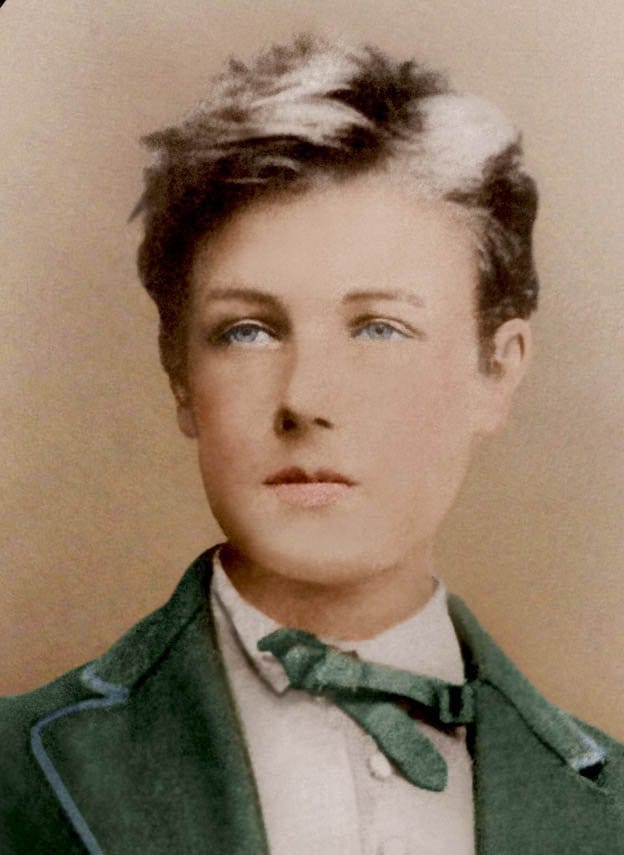The Sleeper in the Valley (Le Dormeur du Val) is a poem known for its powerful imagery and subtle anti-war message, written by French poet Arthur Rimbaud when he was only 16 years old. This work is one of the best-known and most loved of Rimbaud’s poems; though written in 1870, it first appeared in the Anthologie Lemerre, a collection compiled in 1888. The poem describes the peaceful, almost serene image of a young soldier lying in nature, only to reveal in its final lines the devastating truth of the soldier’s death.
The Sleeper in the Valley begins with a vivid description of a peaceful valley where a young soldier lies stretched out in the grass, basking in the warmth of the sun. His face is tranquil, and he appears to be asleep, smiling softly as though in a peaceful slumber. The landscape is filled with sunlight, water, and greenery, suggesting life and vitality. However, the idyllic tone of the poem takes a stark turn when the final line reveals that the soldier is not sleeping but dead, with “two red holes” in his side.
Through this contrast between the beauty of nature and the harshness of death, Rimbaud conveys a powerful anti-war message. The soldier, who should be enjoying the tranquillity of the natural world, has been senselessly killed, a victim of war. The poem reflects the futility and devastation that war brings, disrupting the harmony of life and nature.
Summary
The Sleeper in the Valley begins with a description of the valley, covered in greenery and divided by a rapid stream. Sunlight streams down from high above the nearby mountains, and the speaker describes it as overflowing with light. At the centre of this scene is a young soldier who lays “open-mouthed, bare-headed” on the grass — his neck and feet surrounded by blue and yellow flowers.
The speaker tells us he “sleeps” or “naps” multiple times throughout the second and third stanzas. But also that his skin possesses a pallor similar to that of a “sick child,” and it stands out from the green hues of vegetation around him. The speaker then addresses nature and asks that they “cradle him warmly,” for he is cold.
It’s revealed that none of the smells found in this valley can stir the young soldier’s senses. He is pictured sleeping in the sunlight with a hand on his chest, looking completely “at peace.” Here, the speaker makes a foreshadowed but stunning revelation, explaining that there are “two red holes in his right side.” It is a morbidly ambiguous ending that implies the man has been dead the entire time.
Analysis
The poem contrasts the beauty of nature with the horrors of humanity. The four stanzas of the poem build slowly toward a bleak reveal in the final line. The first three stanzas present a calm, picturesque scene in which nature is praised. The speaker in The Sleeper in the Valley infuses his descriptions with life by assigning human characteristics to inanimate objects. This technique, known as personification, invests the natural world with agency and purpose. Rivers sing, the sun shines, the mountain is proud, and the valley almost overflows with positive energy. The valley is alive not just because the flowers and plants are growing but also because they are actively, joyously living their lives.
The speaker takes this scene and places a person in the centre. The valley is described in terms of movement and action, but the man is always still. The young soldier and his stillness “on his green bed” contrast with the movement of the river and the grass. The speaker suggests that humanity is evidently different, but the serene nature of his pose allows him to exist in the beautiful valley. The valley bathes the young soldier and cradles him. The sleeping soldier becomes a part of the landscape by remaining still and allowing life to flourish around him. The second and third stanzas of the poem suggest that there is a way for humanity to coexist with nature.
The final stanza alters the meaning of the poem. The sleeping soldier is investigated closely. His nostrils do not move, and his hand is laid quietly across his chest. The smell of the flowers and the warmth of the sun have no effect on the soldier. His silence becomes overwhelming, and his failure to acknowledge or even react to the beautiful valley is almost strange. The final line of the poem explains the man’s stillness. The “two red holes in his right side” are bullet wounds. The young soldier is dead, and his stillness is even more starkly contrasted with the valley. The quietness and the lack of movement of the soldier is because he is no longer alive. War has taken his ability to appreciate natural beauty along with his life. The speaker uses the deathly stillness of the soldier to represent the destructive nature of humanity and the enduring brilliance of nature. Humanity cannot help but be violent and will eventually resort to war. Nature will endure throughout these wars and return to its former brilliance. The soldier will rot into the soil of the valley. The speaker explains that humanity’s lust for war will eventually result in total destruction, but nature will re-emerge in the aftermath and reclaim the world just as it has reclaimed the valley and the body of the soldier.

Contrast Between Nature and Death
One of the most striking elements of The Sleeper in the Valley is the contrast between the peaceful natural setting and the tragic reality of the soldier’s death. Rimbaud opens the poem with imagery of a vibrant, living world—a “green hollow,” a river that “sings,” and sunlight playing on the valley. These descriptions evoke a scene full of life and tranquillity. The soldier seems to belong to this serene landscape, lying in the grass, smiling, and appearing to rest peacefully. Nature appears nurturing, even protective, with the grass and flowers surrounding him as if cradling him.
However, this peaceful image is a façade. The soldier, who appears to be “sleeping,” is actually dead, his life violently taken. The final line reveals this harsh truth, with the mention of “two red holes” in his side. The imagery of blood sharply contrasts with the beauty of the natural surroundings, emphasising the intrusion of death into this peaceful environment. The pastoral beauty becomes a cruel irony in the face of war’s brutality.
Subtle Anti-War Message
Though The Sleeper in the Valley is not overtly political, its anti-war sentiment is deeply woven into the fabric of the poem. Rimbaud does not glorify the soldier’s death or depict the battlefield. Instead, he presents the aftermath of war —death hidden beneath the peacefulness of nature. The soldier’s calm demeanour, the smile on his face, and the beauty of the setting create a disturbing disconnect between the scene and the reality of his death. This contrast suggests the senselessness of war, which has taken the life of someone who should be enjoying the peacefulness of the world around him. The poem subtly questions the purpose of war, highlighting its wastefulness by placing the image of the soldier’s death in such a serene setting.
The poem’s anti-war message is intensified by the fact that the soldier appears to be young and innocent, and Rimbaud’s use of the word “child” (he sleeps “like a sick child”) reinforces this image of youthful vulnerability. The soldier has not died gloriously in battle; instead, he lies quietly, almost forgotten in the valley, his death unnoticed by the natural world around him. This lack of heroism underscores the poem’s critique of the futility of war.
The Deceptive Tone and Structure
The tone of the poem is deceptive in its calmness and beauty. The reader is lulled into a false sense of security by the serene imagery, only to be confronted with the soldier’s death in the final line. This tonal shift is crucial to the poem’s structure and emotional impact. The sudden realisation that the soldier is dead —after the reader has been led to believe that he is merely resting —makes the poem’s anti-war message more powerful.
The form of the poem is a sonnet in four stanzas, two quatrains followed by two triads. The rhyme scheme is abab cdcd eef ggf. The poem’s structure follows a natural progression from the description of the valley to the soldier’s appearance to the shocking revelation of his death. The first three stanzas build up a sense of peace, while the final stanza delivers the emotional blow with its chilling final line.
Themes of Nature’s Indifference
In this poem, Rimbaud’s depiction of nature is ambivalent. On the one hand, nature is described as beautiful and serene. On the other hand, nature seems indifferent to the soldier’s death. The valley remains picturesque, the river continues to sing, and the flowers bloom, while the soldier lies dead, unnoticed. The reference to the soldier’s body is cold and the observation that the perfumes of the flowers do not make his “nostrils quiver” further illustrates that nature continues its course, unaffected by the tragedy of human life and death. This indifference could be interpreted as a comment on the harsh realities of war —despite the horrors it inflicts, the world moves on, leaving the dead behind.
Use of Symbolism
Rimbaud employs subtle symbolism to enrich the poem’s meaning. The valley, a symbol of peace and life, becomes the soldier’s final resting place, highlighting the tragic contrast between life and death. The “two red holes” in the soldier’s side symbolise the violence of war, a stark and grotesque intrusion into the beauty of the natural world. The soldier himself, lying peacefully in the grass, becomes a symbol of the innocence and youth destroyed by the violence of war.
The Sleeper in the Valley is a masterful exploration of the contrast between life and death, peace and violence. Through its vivid pastoral imagery and subtle anti-war message, Rimbaud reveals the futility of war and the tragic loss of life it entails. The poem’s serene surface hides a brutal truth, making the final revelation all the more devastating. Rimbaud’s poem remains a timeless reflection on the senselessness of war and its impact on the individual, juxtaposed against the indifferent beauty of nature.



























